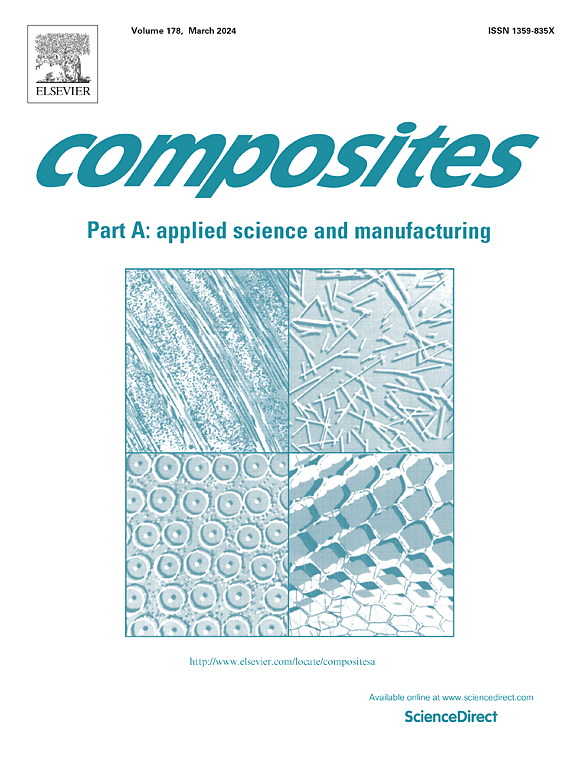Porosity evolution in additively manufactured compression molded short fiber thermoplastics under cyclic loading: Insights from micro-computed tomography and infrared thermography
IF 8.1
2区 材料科学
Q1 ENGINEERING, MANUFACTURING
Composites Part A: Applied Science and Manufacturing
Pub Date : 2025-04-02
DOI:10.1016/j.compositesa.2025.108881
引用次数: 0
Abstract
Composite structures, integral to lightweight, high-performance applications, often suffer from premature fatigue failure due to process-induced defects such as porosity. The recently developed additive manufacturing and compression molding (AM-CM) process enables short fiber thermoplastics (SFTs) with greater fiber orientational control and low porosity. However, the existing pores in SFTs act as fatigue damage initiators, emphasizing the need for a better understanding of the effect of pores on the fatigue behavior of SFTs.
In this study, process defects in 20 wt% carbon fiber reinforced acrylonitrile butadiene styrene (C/ABS) SFTs produced through AM-CM were first identified using ultrasonic inspection and analyzed in detail via micro-computed tomography (-CT). A rapid fatigue testing approach was employed to characterize the cyclic degradation of SFTs, utilizing infrared thermography (IRT) to measure surface temperature changes induced by self-heating, combined with a staircase cyclic loading profile. Porosity evolution in AM-SFTs under cyclic loading was tracked by interrupting the test before the expected fatigue and post-fatigue limits for a precise correlation between defect progression and fatigue performance. The findings demonstrate that increased porosity significantly reduces fatigue resistance, while -CT reveals clustering near fiber ends and within fiber-rich zones as critical contributors to damage initiation. Numerical homogenization, incorporating -CT fiber and pore statistical data within an octree-based algorithm for microstructure generation, validated the experimental observations and provided insights into effective property degradation. This study establishes a robust framework for characterizing fatigue behavior in SFT composites, offering significant potential for improving predictive models and optimizing manufacturing processes to mitigate defects and enhance performance.
循环载荷下增材制造的压缩成型短纤维热塑性塑料的孔隙演化:来自微型计算机断层扫描和红外热成像的见解
复合材料结构是轻量化、高性能应用的重要组成部分,但由于工艺缺陷(如气孔),复合材料结构经常会出现过早疲劳失效。最近开发的增材制造和压缩成型(AM-CM)工艺使短纤维热塑性塑料(SFTs)具有更好的纤维取向控制和低孔隙率。然而,多孔材料中存在的孔隙是疲劳损伤的引发剂,因此需要更好地了解孔隙对多孔材料疲劳行为的影响。在这项研究中,首先利用超声波检测发现了20 wt%碳纤维增强丙烯腈-丁二烯-苯乙烯(C/ABS)经AM-CM生产的SFTs的工艺缺陷,并通过微计算机断层扫描(μ-CT)对其进行了详细分析。采用快速疲劳测试方法来表征SFTs的循环退化,利用红外热像仪(IRT)测量自加热引起的表面温度变化,并结合阶梯循环加载曲线。通过在预期疲劳和疲劳后极限之前中断测试,跟踪AM-SFTs在循环加载下的孔隙度演变,以精确地确定缺陷进展与疲劳性能之间的相关性。结果表明,孔隙率的增加显著降低了抗疲劳性能,而μ-CT显示,纤维末端附近和富纤维区域内的聚簇是引发损伤的关键因素。数值均质化,将μ-CT纤维和孔隙统计数据纳入基于八叉树算法的微观结构生成中,验证了实验观察结果,并为有效的性能退化提供了见解。该研究为表征SFT复合材料的疲劳行为建立了一个强大的框架,为改进预测模型和优化制造工艺以减轻缺陷和提高性能提供了巨大的潜力。
本文章由计算机程序翻译,如有差异,请以英文原文为准。
求助全文
约1分钟内获得全文
求助全文
来源期刊

Composites Part A: Applied Science and Manufacturing
工程技术-材料科学:复合
CiteScore
15.20
自引率
5.70%
发文量
492
审稿时长
30 days
期刊介绍:
Composites Part A: Applied Science and Manufacturing is a comprehensive journal that publishes original research papers, review articles, case studies, short communications, and letters covering various aspects of composite materials science and technology. This includes fibrous and particulate reinforcements in polymeric, metallic, and ceramic matrices, as well as 'natural' composites like wood and biological materials. The journal addresses topics such as properties, design, and manufacture of reinforcing fibers and particles, novel architectures and concepts, multifunctional composites, advancements in fabrication and processing, manufacturing science, process modeling, experimental mechanics, microstructural characterization, interfaces, prediction and measurement of mechanical, physical, and chemical behavior, and performance in service. Additionally, articles on economic and commercial aspects, design, and case studies are welcomed. All submissions undergo rigorous peer review to ensure they contribute significantly and innovatively, maintaining high standards for content and presentation. The editorial team aims to expedite the review process for prompt publication.
 求助内容:
求助内容: 应助结果提醒方式:
应助结果提醒方式:


